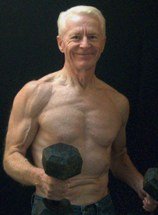Hi

October 15, 2016
In this newsletter . . .
The Lowdown
on High Tech
We just got a new TV, one of those big curved screen models. Its crisp picture and sound draw you right into the action. Sports feel like you’re on the field of play. We love it but also recognize how seductive it is.
With big screen TVs added to smart phones, i-pads, computers, and other tech gizmos, there’s little reason to leave one’s chair, unless to move to the sofa. Even though we know human biological history argues against slouch. For good health, we’ve got to move. Everyday. If we don’t, trouble sets in: heart problems, diabetes, cancers, etc . . . you know the list.
By the time we reach senior status even the most fit of us have acquired at least one or two chronic physical annoyances. Maybe it's a trick knee, a tennis elbow or a bad back. Maybe it's something more serious. But whatever the level, we must not let it condemn us to the couch. Unless your physician, for some valid reason, tells you not to exercise at all -- keep moving. Just be smart in your
approach.
Until almost 60, I still did some martial arts. But as the years added up, I'd often wake up in the morning still tired following a workout the day before. Worse, I'd occasionally make a quick twist or turn, feel a pinch in my spine, and I was in for several days of backache.
I denied the truth for quite a while, but finally gave in to the fact that it was time to face some unpleasant realities about aging. Quick stop-start activities, such as martial arts, and another old favorite, handball, no longer made sense for me. So I bowed out, though I wasn't quite ready for the rocking chair.
Instead, I practiced Qigong (pronounced Chee-kung) for a while and learned new stretching and relaxation techniques. Then after years of absence, I went back to weight training. I approached it cautiously. If I found a particular exercise aggravated something (I'm not talking about normal, mild muscle soreness), I stayed away from that movement. Later in my 60s, I was able to lead cardio-kickboxing classes. They were solid workouts (around the gym they were known as “butt-kickers”), but without actual contact kicking, punching and grappling that is the core of typical martial arts training.
As I reached 70, the pace of the kickboxing classes became more than I could realistically handle. I missed the fun but it was time once again to recognize my limitations. Once again I backed off a little.
Today, I’m 80. I still usually exercise six days per week, alternating resistance training with cardio. My workouts, typically, last half-an-hour, which includes my warm-up and a cool-down. I don’t rush
through workouts, but I move steadily and do not stand around talking. For resistance work, I may use kettlebells or bands, which I’m enjoying more and more. For cardio, I take brisk walks. I’m thinking about buying a bike. I no longer run. And the poundage of any weights that I lift these days is quite moderate.
The gradual paring down approach has worked for me, and it can work for almost anyone as the years add up. Whatever your age, or fitness level, you just have to be smart about training. Get good information and advice. Put solid effort into your workouts, but beware of youthful foolishness. Dirty Harry (Clint Eastwood) was right: "A man’s got to know his limitations." A woman does, too.
If you like the newsletter, we're making it easy to share it . . .





Newsletter Policy
The Gray Iron Fitness Newsletter is a free publication sent twice monthly to subscribers. The purpose is to provide honest and realistic fitness information for people age 50 and above.
I have never been paid or received compensation of any kind to write a positive review or endorse a product. If I say that I personally use a product or service, it is because I find value in it and have paid for it with my own money.
Like newspapers, magazines and television, this newsletter and my web site contain advertising and marketing links. Naturally, I am compensated for these.
The newsletter and web site provide information to help users establish and maintain a fitness lifestyle. But fitness information is not the same as fitness advice, which is the application of exercise and dietary practices to an individual's specific circumstances. Therefore, always consult with your physician for assurance that fitness information, and
your interpretation of it, is appropriate for you.Your comments and questions are always appreciated. Simply click on the "Reply" bottom.
Sincerely,
Logan Franklin
The Gray Iron Fitness Newsletter
www.senior-exercise-central.com



